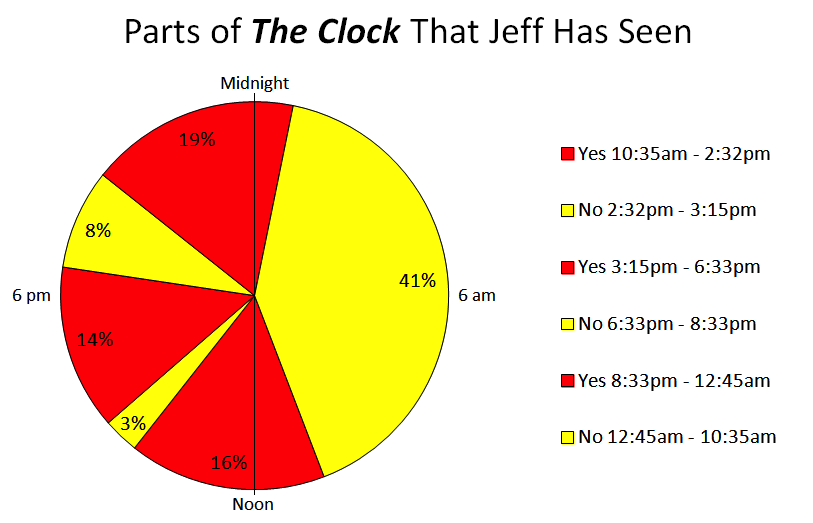Last night I returned to see Christian Marclay’s The Clock at MoMA. This was my third visit; I first saw it at the Lincoln Center Festival in July, from 3:15 p.m. to 6:33 p.m. Here’s what I wrote back then. It’s now at MoMA, and I had to go back because it’s so mesmerizing. Last Friday I saw it from 10:35 a.m. to 2:32 p.m., and last night I went yet again. On weekends it runs 24 hours, and I really wanted to see midnight, as well as 10:04 p.m., when lightning strikes the clock tower in Back to the Future, which I’d read was included.
I got to the museum last night around 8:15. There was just a 10-minute wait to get into the theater; not bad at all. I entered at 8:33 p.m. I worried I’d have to go to the bathroom in the middle of it and thereby forfeit my seat and possibly miss midnight, but I wound up being OK.
Here’s some seating advice for The Clock. The viewing area consists of rows of low white couches. At MoMA, there are three couches per row, forming two interior aisles (in addition to aisles on the sides). I’ve found that the best place to sit is on an interior aisle, on one of the side couches. If you sit on the aisle you get an armrest, and if you sit on a side couch, your view doesn’t get blocked as much if a tall person sits in front of you as it does if you sit on the center couches. It’s something about the way the viewing angles line up.
Anyway, this was by far my favorite visit to The Clock. Every time of day has a different feel, and there’s something about The Clock at night that is just cooler than during the day. There were scenes of people at restaurants, at bars, seeing shows. People at parties. A few people lonely at home watching TV or movies, which was kind of meta. Many creepy nighttime mansions. And many, many bedside clocks: people getting into bed, then, later at night, people getting awoken by portentous phone calls.
As 10:00 p.m. approached, I knew the Back to the Future scene was coming up. At 10:04, lightning struck and Marty McFly traveled through time. The clip was about 20 seconds long, but among the vastness of The Clock it just came and went, and then we were onto the next movie. Kind of anticlimactic.
Then eventually it was 11:00. You could feel people begin to pay more attention as the witching hour grew closer and closer. At 11:30, the minute hand began its final upward sweep. Then it was 11:40, then 11:45, then 11:50, as the angle between the minute and hour hands began diminishing toward nothing. The tension and excitement in the room grew enormously.
11:59. “Get me the governor!” Then: the final seconds before midnight. Each. Punctuated. By. A throbbing. Beat.
And then midnight.
Big Ben exploded in a glorious flash. Clock after clock struck and chimed 12, one after the other, second by second. Orson Welles got stabbed on a clock tower. Mayhem on screen.
During the next few minutes, lots of people left, having gotten what they came for, and other people replaced them. I stayed a while longer. Just after 12:15 there was a long stretch of quiet scenes with no dialogue. A slow panning shot of people asleep on train station benches. A 1940s woman in a mansion welcoming her bleary-eyed husband through the front door. It began to feel late.
I simultaneously wanted to stay and leave. But at some point your brain starts to turn to mush and you just can’t take any more of it. It was time to go home and go to bed. So at 12:45, I left. And it was still full.
The weird thing about The Clock is that it’s playing when you arrive and it’s playing when you leave, and there are people already watching when you arrive and people watching when you leave. You always arrive after the beginning and leave before the end. There’s no other way.
So I have now seen noon and midnight. Noon was really cool, midnight was even better.
This morning I asked Matt if he could help me make a chart of my visits. He created the chart at the top of this page, with my input.
I’ve barely seen the morning hours. I hear the middle of the night has lots of dream sequences and creepy happenings. I’d love to see that, but I don’t see how I’d be able to stay up that late.
Marclay insists that The Clock be shown only in real time. I hope at some point he decides to livestream it online. I don’t know how it work for different time zones, but maybe he could figure that out.
At any rate, the film is at MoMA through January 21, including two more 24-hour weekends. I may have to go back and catch more of the morning hours. I love this film.

